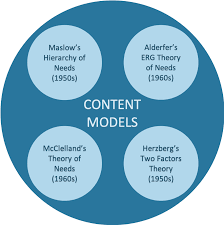Content theories of motivation focus on identifying and categorizing the internal drivers—motives—that energize and direct human behavior in the workplace and beyond. These theories aim to explain what motivates individuals by outlining the types of needs or goals they strive to fulfill, rather than examining how motivation occurs (as in process theories of motivation).
Key content theories include:
-
Maslow’s Hierarchy of Needs: Proposes a five-tier model of human needs, from basic physiological needs to self-actualization.
-
Alderfer’s ERG Theory: Condenses Maslow’s hierarchy into three core needs—Existence, Relatedness, and Growth.
-
Herzberg’s Two-Factor Theory: Distinguishes between hygiene factors (which prevent dissatisfaction) and motivators (which drive satisfaction and performance).
-
McClelland’s Achievement Motivation Theory: Focuses on three learned needs—achievement, affiliation, and power—as key drivers of behavior.
While the label “content theory” suggests a narrow focus on the static elements of motivation, many of these theories also incorporate dynamic and processual elements, such as how needs evolve over time. Nevertheless, they are generally categorized under humanistic motivation theories due to their emphasis on individual growth and self-fulfillment.
Content theories are particularly relevant in organizational behavior and HR management for designing incentive systems, job roles, and leadership strategies that align with intrinsic motivators.
« Back to Glossary Index






